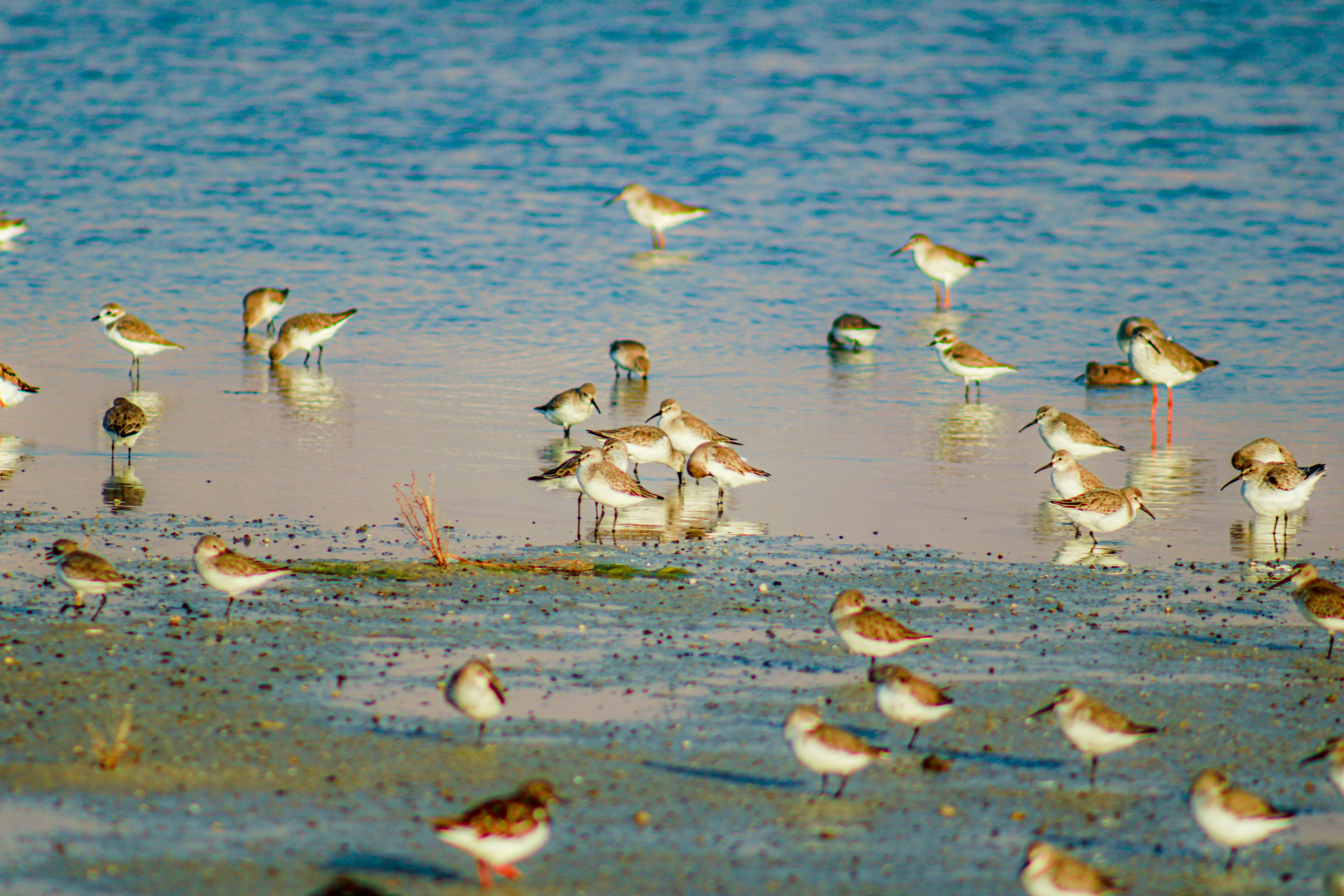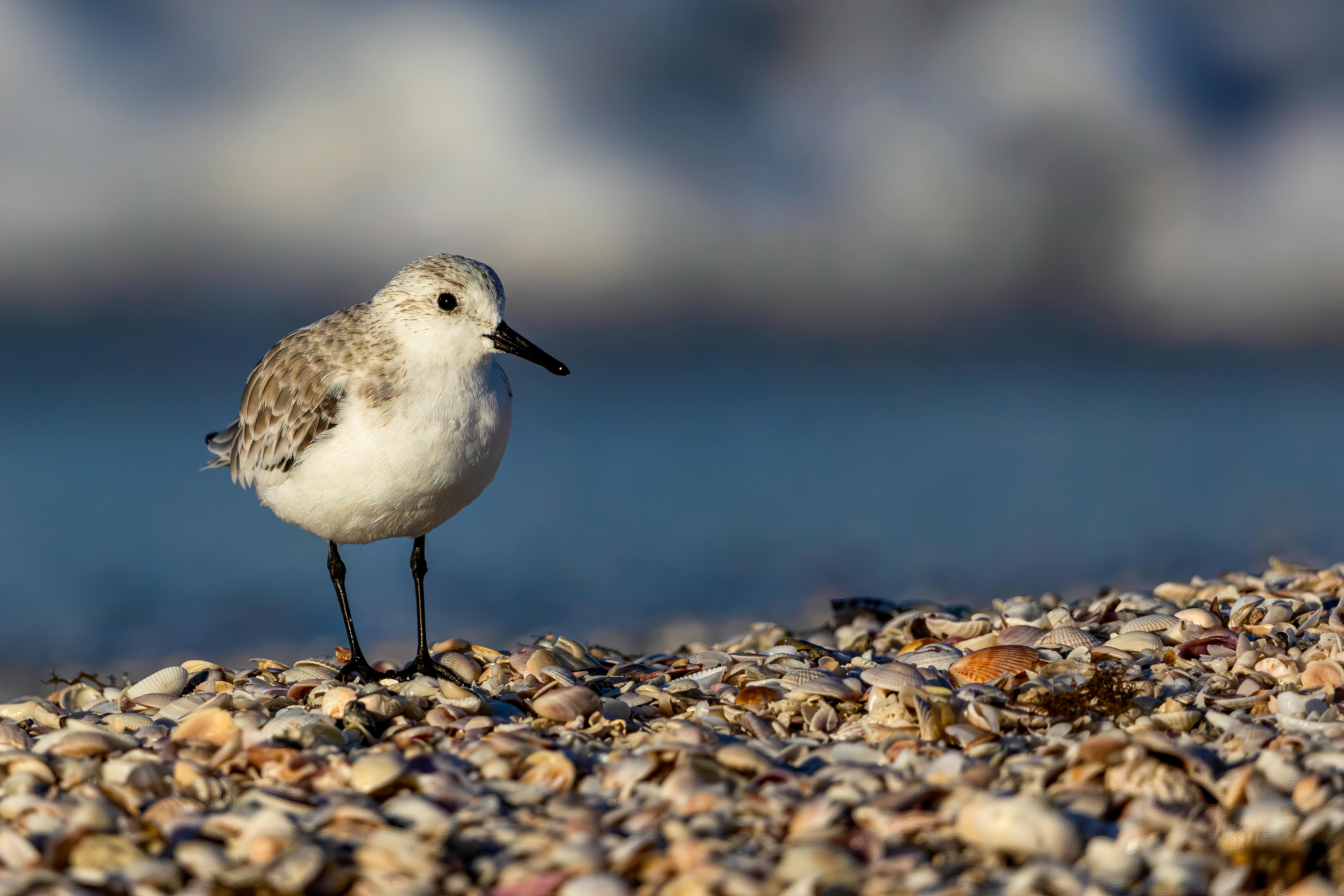Sandpiper is a species of small wading bird that belongs to the Scolopacidae family. These birds are found on every continent except Antarctica and are a common sight on coastal areas, mudflats, and inland shores. They have long wings and legs, enabling them to run across the water’s surface in search of food. Sandpipers use their long bills to probe into mud and sand for small aquatic invertebrates. They also consume plant material such as seeds and berries. They are migratory birds, traveling between their summer breeding grounds in the northern hemisphere to wintering grounds in the southern hemisphere.A sandpiper is a small wading bird that belongs to the family Scolopacidae. These birds are found in many different habitats including wetlands, mudflats, beaches, and coasts. Sandpipers usually feed on small invertebrates such as insects, crustaceans and worms. They are typically brown or gray in color with long legs, long beaks and long wings. Sandpipers can be seen alone or in flocks, often flying in V-formation.
Contents
Physical Characteristics
Sandpipers are a type of migratory bird that belong to the Scolopacidae family, which includes over 200 species. These birds are typically medium-sized and long-legged, and they have short, pointed wings and long bills. They come in a variety of colors and have different types of plumage, including streaked feathers, barred feathers, spotted feathers, or plain feathers. The coloration varies depending on the species and can range from a light brown to dark gray to black. Sandpipers usually weigh between 3 and 8 ounces (85 to 225 grams) and their wingspan can range from 12 to 36 inches (30 to 91 centimeters).
Habitat
Sandpipers inhabit a wide range of habitats across the world, including shorelines, wetlands, grasslands, tundra, marshes, deserts, estuaries and even agricultural lands. They mostly live in temperate climates but some species can be found in more tropical regions. During the winter months they migrate southward while some may stay in their summer habitat year-round.
Diet
The diet of sandpipers varies depending on their species but generally consists of insects such as ants or beetles as well as other arthropods like spiders or worms. They may also feed on berries or seeds if available. Sandpipers use their long bills to probe mudflats or shallow water for food items while they are wading through water or walking along shorelines.
Behavior
Sandpipers typically live in large flocks and can often be seen foraging together on shorelines or mudflats. They are also known for their characteristic running movements when searching for food along the beachfronts. Sandpipers usually nest in shallow depressions near water sources such as lakes or rivers and during breeding season they become very territorial over these areas.
Habitat of a Sandpiper Animal
Sandpipers are found in a wide range of habitats, from coastal areas to inland wetlands. They prefer open, shallow water habitats such as estuaries, ponds, marshes, and mudflats. Some species can be found in grasslands and even deserts. These shorebirds can also be found in the Arctic tundra during the summer months. Sandpipers usually live in small flocks and may migrate thousands of miles in search of food sources. They often forage for food in shallow water or on mudflats, probing the muddy bottom with their bills to find worms and crustaceans. They also feed on insects and sometimes on seeds or berries. Sandpipers typically nest on the ground near water sources but some species may nest in trees or shrubs if necessary.
Diet of a Sandpiper Animal
The diet of a sandpiper animal varies from species to species. Generally, they feed on small invertebrates such as insects, worms, mollusks, crustaceans and other aquatic animals like fish. They are also known to eat seeds, grains, and berries. Sandpipers have been seen eating in shallow water or on the ground near water sources. They can also be found feeding in small pools or along the shoreline. Sandpipers have evolved a variety of feeding strategies to make sure they get enough food; some species will use their long bills to probe the mud for food while others will pick up food items from the surface of the water or ground.
Sandpipers are known for their agility and speed when it comes to catching prey. They can run across wet surfaces or fly short distances in order to catch their meals. While most sandpiper species feed alone, some species may form flocks when foraging for food in order to increase their chances of finding a meal.
Most sandpipers migrate during the winter months in search of more abundant food sources. When they migrate, sandpipers may travel long distances in search of food, sometimes crossing entire continents. During these migrations, sandpipers rely on a variety of habitats such as wetlands and grasslands for food sources.
Breeding Habits of a Sandpiper Animal
The breeding habits of a sandpiper animal vary greatly depending on its species. Many species of sandpipers migrate to breed in the spring months, while some will remain in their wintering grounds year-round. Most species build nests on the ground in open or semi-open habitats such as grassy fields, tundra, beaches, and marshes. The male will typically construct the nest using reeds and other materials from the local terrain. The female then lines the nest with softer materials such as feathers to provide warmth and protection for her eggs.
Once the eggs are laid they are incubated by both sexes for approximately three weeks before hatching. After hatching, the chicks are cared for by both parents until they are able to fly at around four weeks old. At this point they will leave their parents’ care and become independent.
Sandpipers typically have one brood per breeding season but may have two if conditions are favorable. If a pair has a second brood, it is usually much smaller than the first due to a lack of resources and energy from the parents. It is also less likely that all chicks from a second brood will survive due to predation and competition for food with older siblings from the first brood.

Migration Routes of a Sandpiper Animal
The sandpiper is an iconic shorebird that can be seen along the coasts and wetlands of the world. These small birds migrate long distances each year, often travelling from their breeding grounds in the Arctic to wintering grounds as far south as South America. Tracking the migration routes of these birds gives us a fascinating insight into their behaviour and helps us to better understand their ecology and conservation needs.
Sandpipers typically migrate in distinct patterns, often following well-worn routes that have been used by generations of birds. This allows them to take advantage of favourable winds, currents and weather conditions while minimising their energy expenditure. In some cases, they will even follow coastlines or mountain ridges, taking advantage of thermals that are created as warm air rises up along these features.
Recent studies using satellite tracking technology have revealed some remarkable facts about the migration routes of sandpipers. For example, birds breeding in Alaska have been found to fly more than 8,000 kilometers (5,000 miles) southwards each year, crossing the Bering Strait before heading down through western North America and continuing on to Mexico or Central America. Other birds from Scandinavia have been observed travelling even further – sometimes all the way down to Patagonia in South America!
Tracking sandpiper migration routes is important for understanding how these birds respond to changing environmental conditions such as climate change and other human impacts. By understanding how sandpipers use different habitats during different parts of their life cycle, we can work towards conserving crucial stop-off points along their migratory route and ensure that these amazing animals can continue to make their incredible journeys for many generations to come.
Predators of a Sandpiper Animal
The sandpiper is a small to medium-sized wading bird that can be found on the shorelines of oceans, lakes, and rivers around the world. Despite its small size, this bird has many predators. Birds of prey such as hawks, eagles, and owls are some of the most common predators of the sandpiper. These birds hunt by swooping down from high above and snatching up the unsuspecting sandpiper.
Ground predators such as cats, foxes, and raccoons also hunt sandpipers. These animals wait along the shoreline for their chance to snatch a meal from an unsuspecting bird. Smaller mammals like rats and mice also pose a threat to the sandpiper. These animals typically wait for their opportunity to snatch a meal from an already dead or injured bird.
Other aquatic creatures such as fish, turtles, and crabs also pose a threat to sandpipers. Fish will often ambush sandpipers when they come close to the water’s edge in search of food or shelter. Turtles may also try to grab a meal by scooping up an unsuspecting bird while it is standing in shallow water. Crabs will sometimes reach up out of their burrows and grab at any passing sandpiper that is too close for comfort.
Human activity can also be dangerous for these birds as well. Sandpipers can become tangled in fishing lines or nets left unattended by fishermen. They may also be accidentally run over by vehicles driving on shorelines or caught in traps meant for other animals such as crabs or rodents.
Although these birds are small in size, they do have some protection against predators due to their quick reflexes and ability to fly away quickly when threatened. They will often group together with other sandpipers when threatened which gives them added protection against potential predators looking for an easy meal.
Conservation Status of a Sandpiper Animal
The conservation status of a sandpiper animal is of great concern. Sandpipers are migratory birds that depend on coastal habitats for their survival. Unfortunately, these areas are being degraded through human activities such as overfishing and coastal development. In addition, climate change is causing sea levels to rise, which is threatening the availability of food sources for sandpipers. As a result, their populations have been declining steadily in recent years.
The International Union for Conservation of Nature (IUCN) has classified the majority of sandpiper species as vulnerable or near-threatened due to their depleted numbers and the threats they face in their habitat. For example, the Red Knot (Calidris canutus) is classified as vulnerable, while the Spotted Redshank (Tringa erythropus) is classified as near-threatened. The IUCN also lists several other species of sandpipers as critically endangered due to their extreme rarity or small population size.
In order to ensure the future survival of sandpipers, it is essential that we work together to protect their habitats and reduce human pressures on them. This includes limiting coastal development and implementing sustainable fishing practices. Additionally, we must work together to mitigate climate change and its effects on sea levels and food availability for these birds. With concerted efforts from both government agencies and private organizations, we can help ensure that sandpipers remain a part of our natural world for generations to come.

Conclusion
Sandpipers are fascinating birds, with incredible adaptations to their environment and many unique behaviors. From their remarkable migration patterns to their diet of small invertebrates, sandpipers have a lot to offer in terms of understanding the world around us. They play an important role in many ecosystems, both coastal and inland, and help contribute to the health of the environment. As humans continue to encroach on natural habitats, sandpipers will be integral in assisting with conservation efforts for these areas. With careful observation and study, we can learn more about these remarkable creatures and appreciate their place in the world.
In conclusion, sandpipers are a remarkable species that demands our attention and appreciation for its astounding adaptations and behaviors. Through further study of these birds, we can learn more about how to conserve their habitats so that they can continue to thrive for generations to come.

0 Comments